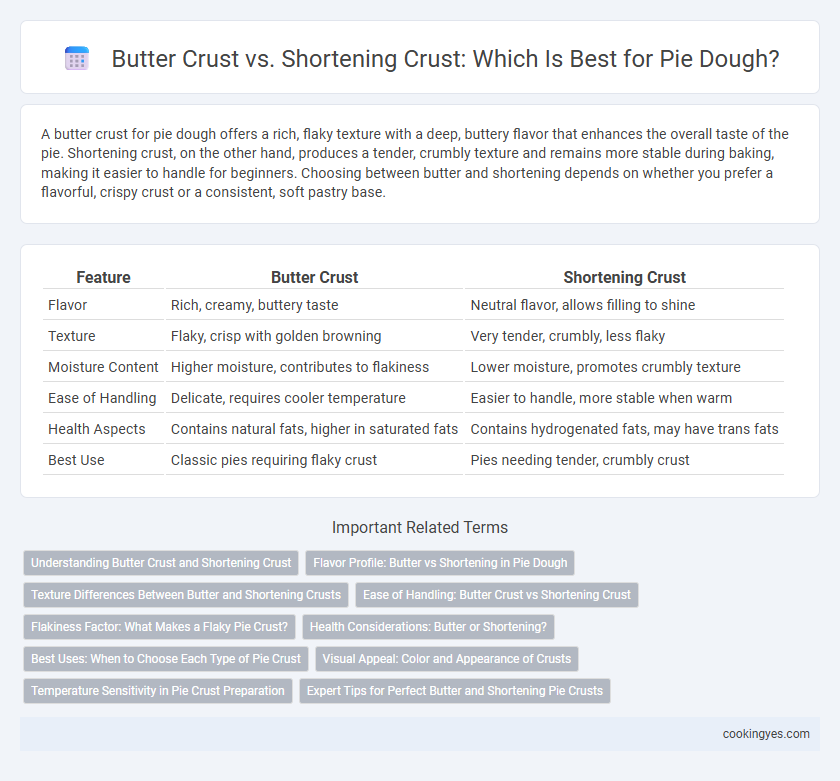A butter crust for pie dough offers a rich, flaky texture with a deep, buttery flavor that enhances the overall taste of the pie. Shortening crust, on the other hand, produces a tender, crumbly texture and remains more stable during baking, making it easier to handle for beginners. Choosing between butter and shortening depends on whether you prefer a flavorful, crispy crust or a consistent, soft pastry base.
Table of Comparison
| Feature | Butter Crust | Shortening Crust |
|---|---|---|
| Flavor | Rich, creamy, buttery taste | Neutral flavor, allows filling to shine |
| Texture | Flaky, crisp with golden browning | Very tender, crumbly, less flaky |
| Moisture Content | Higher moisture, contributes to flakiness | Lower moisture, promotes crumbly texture |
| Ease of Handling | Delicate, requires cooler temperature | Easier to handle, more stable when warm |
| Health Aspects | Contains natural fats, higher in saturated fats | Contains hydrogenated fats, may have trans fats |
| Best Use | Classic pies requiring flaky crust | Pies needing tender, crumbly crust |
Understanding Butter Crust and Shortening Crust
Butter crust provides a rich flavor and flaky texture due to its water content, which creates steam during baking, while shortening crust offers superior tenderness and a higher melting point, preventing shrinkage. Butter crust often results in a golden-brown color and a more delicate, flavorful bite, essential for fruit pies and tarts. Shortening crusts are favored for their ease of handling and consistent texture, ideal for cream pies and quiches where a sturdy base is required.
Flavor Profile: Butter vs Shortening in Pie Dough
Butter crust pie dough delivers a rich, creamy flavor with a slightly nutty undertone, enhancing the overall taste and aroma of the pie. Shortening crust offers a more neutral flavor, allowing the pie filling to take center stage without added buttery notes. Choosing butter results in a more flavorful and aromatic crust, while shortening provides a tender texture with less impact on the pie's flavor profile.
Texture Differences Between Butter and Shortening Crusts
Butter crusts yield a flaky, tender texture due to the water content in butter creating steam during baking, which helps separate dough layers. Shortening crusts produce a softer, more crumbly texture because shortening lacks water and melts more evenly, resulting in less steam and a denser dough. Bakers often blend butter and shortening to balance flakiness and tenderness in pie crusts.
Ease of Handling: Butter Crust vs Shortening Crust
Butter crust offers a more pliable and tender dough, making it easier to roll out without cracking, thanks to its higher water content and natural fats. Shortening crust tends to be firmer and less sticky, which can simplify handling for beginners by reducing the need for excessive flour during rolling. While butter crust provides superior flavor, shortening crust is often preferred for its consistent texture and ease of manipulation in pie dough preparation.
Flakiness Factor: What Makes a Flaky Pie Crust?
Butter crusts create a flaky pie crust due to the water content in butter, which turns to steam during baking and separates the dough layers. Shortening crusts contain no water, resulting in less steam and a tender, crumbly texture rather than distinct flakiness. The key flakiness factor lies in how the fat melts and creates layers, with butter providing superior lift and crispness compared to shortening.
Health Considerations: Butter or Shortening?
Butter crust offers natural fats and contains vitamins A and E, but also higher levels of saturated fat and cholesterol, which may impact heart health if consumed in excess. Shortening crust is made from hydrogenated vegetable oils, often containing trans fats that can elevate bad cholesterol and increase cardiovascular risk. Choosing between butter and shortening crusts depends on balancing flavor preferences with health goals, favoring non-hydrogenated shortening or butter in moderation for a healthier pie dough option.
Best Uses: When to Choose Each Type of Pie Crust
Butter crust offers a rich flavor and tender texture, making it ideal for pies where a flaky, buttery taste enhances the filling, such as apple or berry pies. Shortening crusts provide superior flakiness and structural stability, best suited for savory pies or those requiring a sturdier base, like pot pies or quiches. For balanced flavor and texture, combining butter with shortening can deliver both tenderness and durability in pie dough.
Visual Appeal: Color and Appearance of Crusts
Butter crusts typically produce a rich golden-brown color with a slightly glossy finish due to the milk solids caramelizing during baking. Shortening crusts tend to result in a paler, more matte appearance with a uniform texture because shortening lacks water and milk solids. The choice between butter and shortening significantly influences the pie's visual appeal, making butter ideal for an inviting, warm color and shortening preferable for a more neutral, consistent look.
Temperature Sensitivity in Pie Crust Preparation
Butter crusts provide superior flavor but are highly temperature sensitive, requiring cold conditions to prevent melting and ensure flakiness. Shortening crusts are more stable at higher temperatures, making them easier to handle without risk of melting but often lack the rich taste of butter. Maintaining cold temperatures during preparation is critical for both to achieve optimal texture and structure in pie dough.
Expert Tips for Perfect Butter and Shortening Pie Crusts
Expert tips for achieving the perfect butter crust include using cold butter to create flaky layers and gently handling the dough to avoid melting the fat prematurely. For shortening crusts, prioritizing chilled shortening and minimal water addition ensures a tender yet sturdy texture ideal for holding fillings. Combining techniques like cutting fat into coarse crumbs for butter and evenly distributing shortening can elevate pie crust quality for both varieties.
Butter crust vs Shortening crust for pie dough Infographic

 cookingyes.com
cookingyes.com